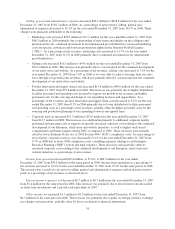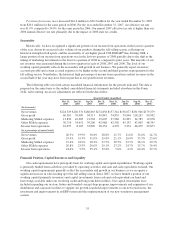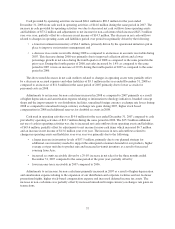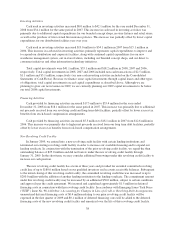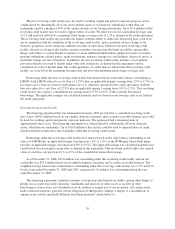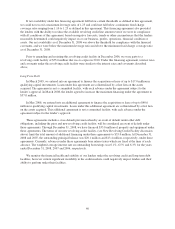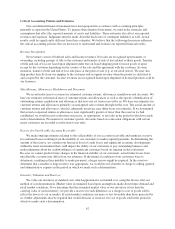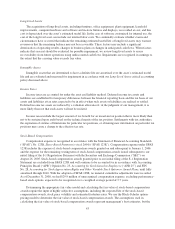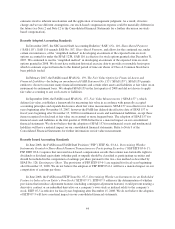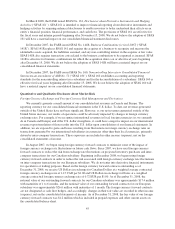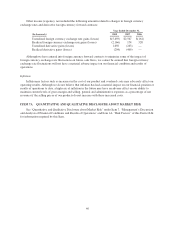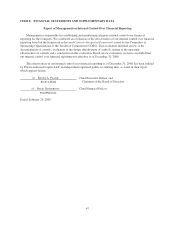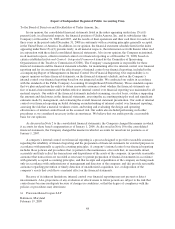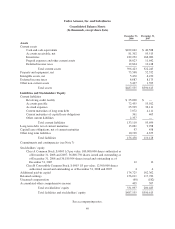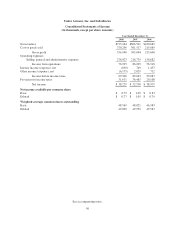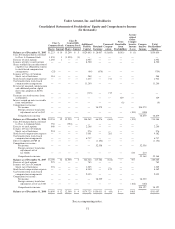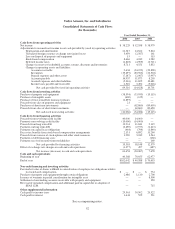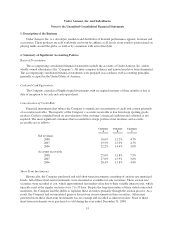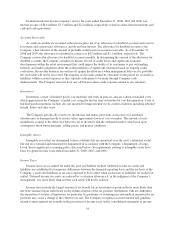Under Armour 2008 Annual Report Download - page 52
Download and view the complete annual report
Please find page 52 of the 2008 Under Armour annual report below. You can navigate through the pages in the report by either clicking on the pages listed below, or by using the keyword search tool below to find specific information within the annual report.estimates involve inherent uncertainties and the application of management judgment. As a result, if factors
change and we use different assumptions, our stock-based compensation expense could be materially different in
the future (see Note 2 and Note 12 to the Consolidated Financial Statements for a further discussion on stock-
based compensation).
Recently Adopted Accounting Standards
In December 2007, the SEC issued Staff Accounting Bulletin (“SAB”) No. 110, Share-Based Payment
(“SAB 110”). SAB 110 amends SAB No. 107, Share-Based Payment, and allows for the continued use, under
certain circumstances, of the “simplified method” in developing an estimate of the expected term on stock
options accounted for under the SFAS 123R. SAB 110 is effective for stock options granted after December 31,
2007. We continued to use the “simplified method” in developing an estimate of the expected term on stock
options granted in 2008. We do not have sufficient historical exercise data to provide a reasonable basis upon
which to estimate expected term due to the limited period of time our shares of Class A Common Stock have
been publicly traded.
In February 2007, the FASB issued SFAS No. 159, The Fair Value Option for Financial Assets and
Financial Liabilities—Including an amendment of FASB Statement No. 115 (“SFAS 159”). SFAS 159 permits
entities to choose to measure many financial instruments and certain other assets and liabilities at fair value on an
instrument-by-instrument basis. We adopted SFAS 159 in the first quarter of 2008 and did not choose to apply
fair value accounting to any such assets or liabilities.
In September 2006, the FASB issued SFAS No. 157, Fair Value Measurements (“SFAS 157”), which
defines fair value, establishes a framework for measuring fair value in accordance with generally accepted
accounting principles and expands disclosures about fair value measurements. SFAS 157 was effective for fiscal
years beginning after November 15, 2007, however the FASB has delayed the effective date of SFAS 157 to
fiscal years beginning after November 15, 2008 for nonfinancial assets and nonfinancial liabilities, except those
items recognized or disclosed at fair value on an annual or more frequent basis. The adoption of SFAS 157 for
financial assets and liabilities in the first quarter of 2008 did not have a material impact on our consolidated
financial statements. We do not believe that the adoption of SFAS 157 for nonfinancial assets and nonfinancial
liabilities will have a material impact on our consolidated financial statements. Refer to Note 9 of the
Consolidated Financial Statements for further information on fair value measurement.
Recently Issued Accounting Standards
In June 2008, the FASB issued FASB Staff Position (“FSP”) EITF No. 03-6-1, Determining Whether
Instruments Granted in Share-Based Payment Transactions are Participating Securities (“FSP EITF 03-6-1”).
FSP EITF 03-6-1 requires that unvested stock-based compensation awards that contain non-forfeitable rights to
dividends or dividend equivalents (whether paid or unpaid) should be classified as participating securities and
should be included in the computation of earnings per share pursuant to the two-class method as described by
SFAS No. 128, Earnings per Share. The provisions of FSP EITF 03-6-1 are required for fiscal years beginning
after December 15, 2008. We do not believe the adoption of FSP EITF 03-6-1 will have a material impact on our
computation of earnings per share.
In June 2008, the FASB issued EITF Issue No. 07-5, Determining Whether an Instrument (or an Embedded
Feature) is Indexed to an Entity’s Own Stock (“EITF 07-5”). EITF 07-5 addresses the determination of whether
provisions that introduce adjustment features (including contingent adjustment features) would prevent treating a
derivative contract or an embedded derivative on a company’s own stock as indexed solely to the company’s
stock. EITF 07-5 is effective for fiscal years beginning after December 15, 2008. We do not believe the adoption
of EITF 07-5 will have a material impact on our consolidated financial statements.
44


